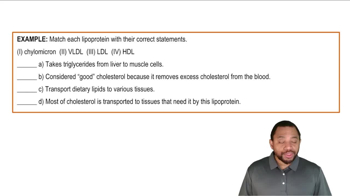Classify the following carbohydrates as a monosaccharide, disaccharide, oligosaccharide, or polysaccharide:
(a) carageenan, a seaweed extract containing up to 25,000 carbohydrate units
 Verified step by step guidance
Verified step by step guidance



Classify the following carbohydrates as a monosaccharide, disaccharide, oligosaccharide, or polysaccharide:
(a) carageenan, a seaweed extract containing up to 25,000 carbohydrate units
Classify the following carbohydrates as a monosaccharide, disaccharide, oligosaccharide, or polysaccharide:
(a) raffinose, a soluble fiber containing three carbohydrate units
Identify the following as characteristics of soluble or insoluble fiber:
(a) can mix with water
Identify the following monosaccharides as the d- or the l-isomer:
(a) <IMAGE>
Use the structure of d-galactose in Problem 6.15 to answer the following:
(b) Draw the Fischer projection of l-galactose.
ALLIED Health Indicate whether the following statements apply to type 1 or type 2 diabetes:
(c) can be managed with diet and exercise